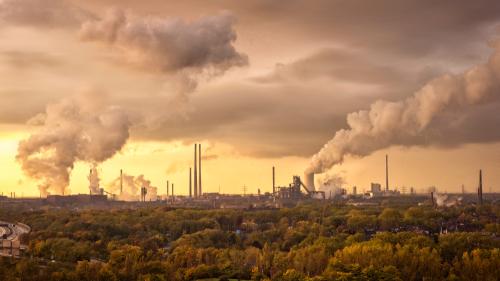You can watch video of a Hutchins Center discussion, “Social cost of carbon: What it is, why it matters, and why the Biden administration seeks to raise it,” here. The panel includes Coral Davenport of the New York Times, Noah Kaufman of Columbia University, Brian Prest of Resources for the Future, and Glenn Rudebusch of Brookings.
The social cost of carbon (SCC) is an estimate of the cost, in dollars, of the damage done by each additional ton of carbon emissions. It also is an estimate of the benefit of any action taken to reduce a ton of carbon emissions.
How is the social cost of carbon used?
Policymakers who are weighing regulatory proposals that may increase or curb carbon emissions can use the SCC as an input to their decisions. For example, if a policy to prevent one ton of carbon emissions costs less than the SCC, then the benefits of the policy outweigh the costs and it pays for itself in the long run. If the policy is more expensive than the SCC, the costs outweigh the benefits. Currently, the federal governments of both the U.S. and Canada, as well as several states, use the SCC when considering policy options.
The SCC has been used to determine fuel economy standards in the U.S., and five states require electric utility companies to consider the SCC in their operations. Though these considerations might increase household and business expenses in the short term, if a policy costs less than the SCC, excess carbon emissions in the long term would have cost society even more than the increased prices of goods in the short term.
What are the estimates of the social cost of carbon?
They vary. The Obama administration initially estimated the social cost of carbon at $43 a ton globally, while the Trump administration only considered the effects of carbon emissions within the United States, estimating the number to be between $3 and $5 per ton. As it stands, the official estimate from the Biden administration is $51, but in November 2022, the EPA proposed a nearly fourfold increase to $190. (The EPA is weighing public comments on that proposal.)
How is the SCC calculated?
When calculating the social cost of carbon, climate scientists and economists create models to predict what will happen to a range of indicators when new carbon dioxide is put into the atmosphere. Among these indicators are health outcomes, agricultural production, and property values. An extra ton of carbon emissions shortens lifespans, hurts crops, and causes sea levels to rise, decreasing property values. An SCC of $51 means that economists and climate scientists expect the total damages from an extra ton of carbon emissions to equal $51 a ton.
Estimates vary for several reasons, in part because the calculation requires many assumptions. First, models differ in how much they expect carbon emissions to affect the chosen indicators. Even within the same model, the range of possible outcomes for a given indicator—say, temperature increases—can vary widely. Second, two models may value the same outcome differently. Many social goods that are negatively affected by carbon emissions, like human health, don’t have agreed-upon prices. The values of these goods have a large impact on an estimated SCC, but economists disagree on the specific numbers. Third, some models only consider the effects of a given outcome on the U.S., and thus estimate the level of the SCC much lower than those that consider global effects of additional carbon emissions. Lastly, when economists use different discount rates—a measure of how much we value the present compared to the future—the estimates can change significantly. The EPA’s $190 estimate uses a 2% discount rate. When they use a higher discount rate of 2.5%, thus valuing the future less, the SCC goes down to $120. When they use a 1.5% discount rate, valuing the future more, the SCC shoots up to $340.
Are there alternatives to using the social cost of carbon?
One alternative is to take a goal—say, reducing emissions of carbon dioxide by 50% by 2030—and then estimating how much it would cost each year to achieve a reduction of a ton of carbon. This is called “target-consistent pricing” and has been advocated by, among others, prominent economists Joseph Stiglitz and Nicholas Stern.
The Brookings Institution is financed through the support of a diverse array of foundations, corporations, governments, individuals, as well as an endowment. A list of donors can be found in our annual reports published online here. The findings, interpretations, and conclusions in this report are solely those of its author(s) and are not influenced by any donation.







Commentary
What is the social cost of carbon?
March 14, 2023